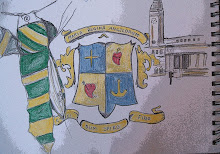As you can see from the images, the signs are very large and appear on the walls next to what it is they are representing, such as currency exchange, toilets and food services. These symbols guide the traveller in the airport and so also act as a reassurance for them. The design of these symbols is consistent with the use of space to create shape and also curves to the design. As well as that, the use of the colour blue is apparent on all of the symbols, which shows that there is a link between the signage as it all appears within the airport. This style of design with the incorporation of consistency through colour brings about professionalism, which is something that people in the airport would want to feel. As they are waiting to board a plane, which can be quite daunting for some, feeling comfortable and knowing their surroundings would be key to the audience of travellers.
Creating pictograms as large as this would work well, particularly in an airport, which can be very spacious. Facilities may not be in close proximity to where it is you are waiting in the airport. This would mean that the large pictograms would be eye catching on the wall and would be good at informing people who may be quite far away from them, meaning that they could spot them from a distance. This may be something that I would have to bear in mind when I am designing the pictograms for the university departments.





No comments:
Post a Comment